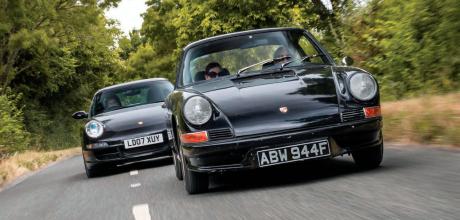1968 Porsche 912 vs. 2007 911 Carrera S 997.1
In the latest instalment of our series showcasing readers rides, we head to Hitchin and meet the owners of a 1968 912 and a 2007 997 Carrera S. Two very different Porschesthey may be, but these black beauties share more in common than you might think...
Words Dan Furr
Photography Dan Sherwood
LOST AND FOUND
A 1968 912 meets a 2007 997 Carrera S.
How many classic cars can you squeeze into the centre of a North Hertfordshire market town? If you’re keen to find out, hop online and search for H-Town Classic & Dub Club. One of Britain’s fastest-growing classic car enthusiast groups, members gather on the last Monday of every month at the market square in historic Hitchin, a town with fast links to London, the Midlands and the southeast of England. It also happens to be the place of my birth, as well as a location recently depicted as the home of Doctor Foster, the character played by Suranne Jones in the bafflingly popular BBC drama of the same name.
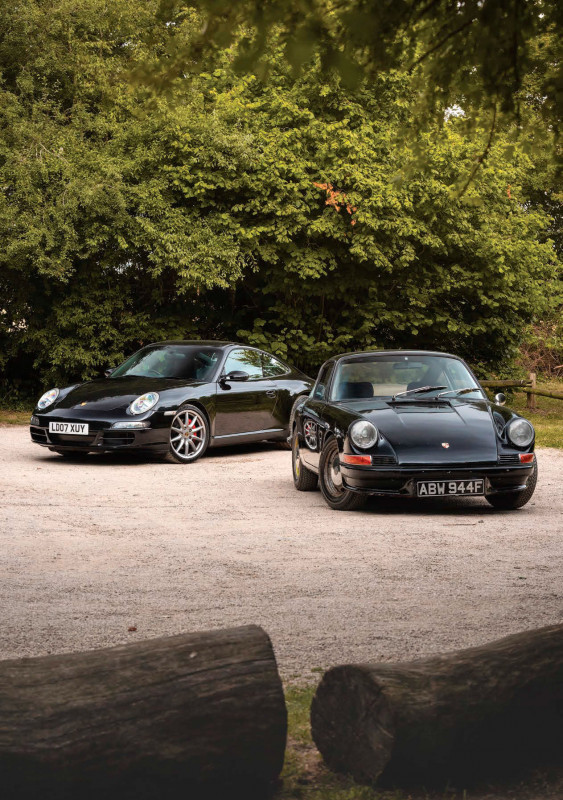
Felix Camfield-Walker, a familiar face in Hitchin and proprietor of local hair salon, Farley’s, established the club in 2017 after struggling to find a local enthusiast group catering for all makes and models of vintage vehicle. After setting up a Facebook page and inviting everyone in Hitchin and the surrounding area to attend the first of what he hoped would develop into monthly meets, a total of thirty-four classics pulled into the car park of the pub hosting the event. Early Volkswagens, air-cooled Porsches, a Citroën 2CV, a beach buggy, various MGs, Fords and even a chap riding a Lambretta showed up.
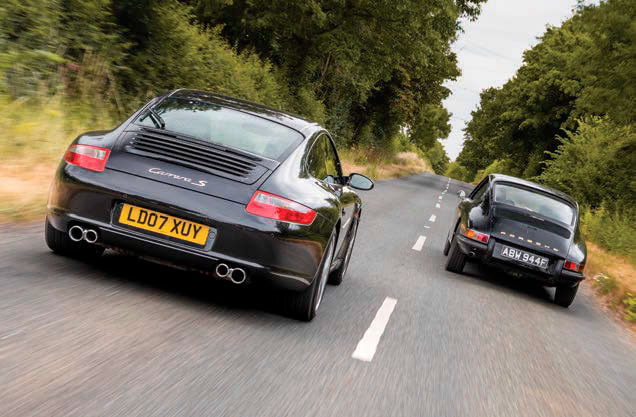
Clearly, Felix wasn’t the only petrolhead in Hertfordshire craving the existence of an informal car club, which is why he contacted Hitchin Initiative, a highly effective partnership founded to ensure the town thrives through the efforts of businesses, community organisations, residents and the local authority. His request was to occupy Hitchin market square on the last Monday of every month, thereby allowing a far greater number of cars and owners to be present at meets than the pub could accommodate. Pleasingly, the idea was welcomed, leading H-Town Classic & Dub Club gatherings to be hosted in the centre of town thereafter.
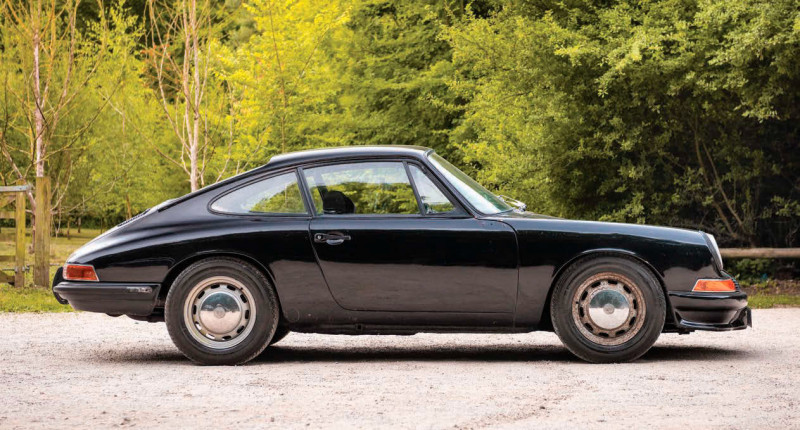
Today, the club’s reach has extended far beyond the borders of North Hertfordshire — from a strong start, the number of attending vehicles has increased massively. Indeed, more than 150 cars are regularly counted at each meeting. Occupying the market square, overflow car parks and the surrounding cobbled streets, visitors and their retro rides travel to Hitchin from afar, a consequence of members of less active clubs enjoying the fact H-Town Classic & Dub Club hosts its brilliant free-to-visit meets year-round.
DESPITE BEING A REAR-ENGINED SPORTS COUPÉ LIKE THE 356 BEFORE IT, THE 911 WAS ALWAYS GOING TO BE CONSIDERABLY MORE EXPENSIVE
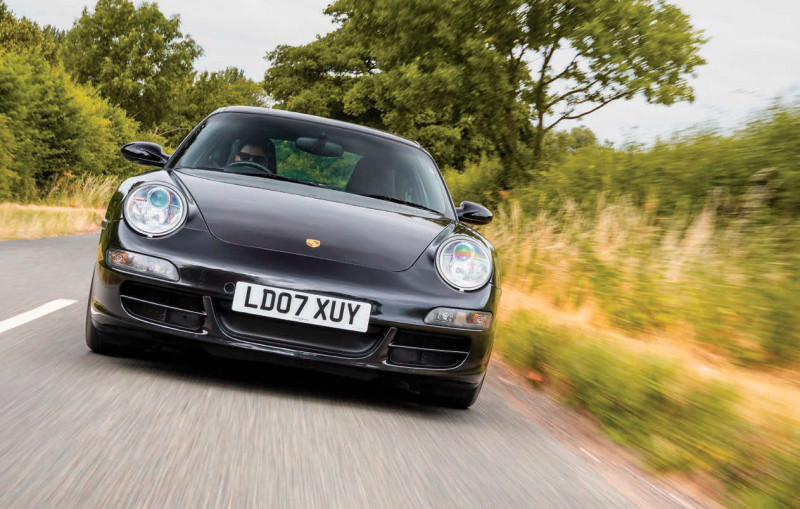
Unsurprisingly, with sunshine comes a much higher number of participating cars. To avoid causing chaos in Hitchin town centre, club meets shift to the grounds of a watering hole in a neighbouring village during the summer season, but return to the market square — the club’s spiritual home — at the start of autumn. In fact, just before this issue of 911 & Porsche World went to print, the market square played host to H-Town Classic & Dub Club’s fifth birthday bash.
THE REAR-ENGINE LAYOUT AND REVHAPPY BOXER ENGINE IN EACH CAR PROVIDES A THRILL CONVENTIONAL CONFIGURATION CAN’T MUSTER
As the club’s name suggests, a high number of Volkswagens make an appearance at its highly anticipated get-togethers — it’s no coincidence Felix was using a fifty-year-old Beetle as his daily drive when the group was founded. It should, then, come as little surprise to discover each H-Town Classic & Dub Club meet also welcomes a high number of Porsches, from air-cooled classics, including the 356 and early 911s, through to watercooled Neunelfers and transaxle models. The 924 and 944 are particularly well represented, as is the 964, 996, 997 and the first two generations of Boxster.
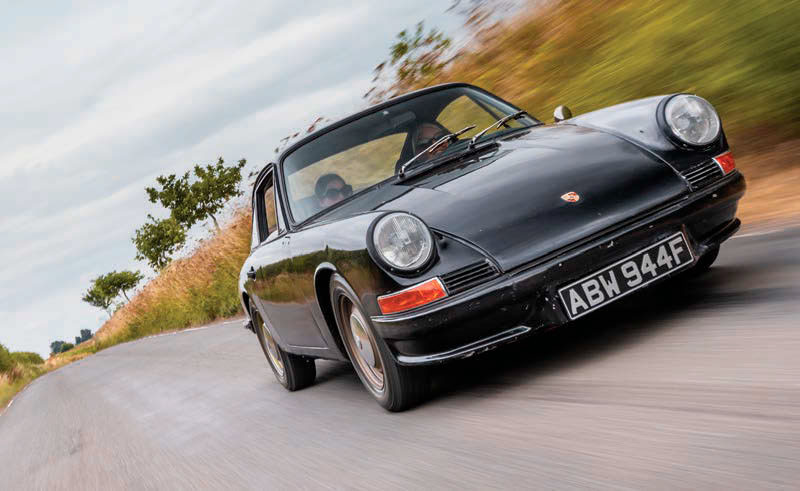
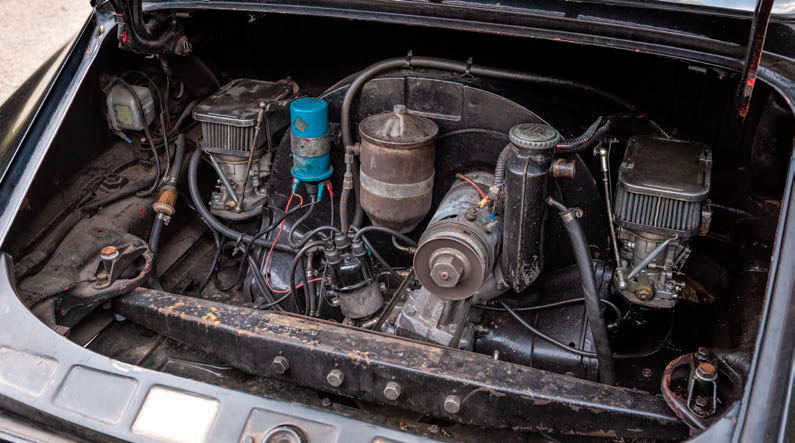
There’s much more to H-Town Classic & Dub Club than German cars, though. Happily sitting alongside split-screen campers, Karmann Ghias, old Golfs, M-badged Bimmers and Mercedes SLs, you’ll find the same eclectic mix of metal witnessed at the club’s very first meet, with the added spice of vintage Ferraris, American hot rods, Minis, classic French fancies and a range of old-school joy toys from the Land of the Rising Sun. Among the Stuttgart-crested cars you’ll spot at H-Town meets are the two black beauties you see here. They’re two very different Porsches, but have a lot in common. Let’s start with the 912, a 1968 build owned by local florist, Sarah Maylin. We’ve championed the 912 in previous issues of 911 & Porsche World, but beyond the model’s low price point (when compared to a same-age 911), what is this four-cylinder Porsche’s appeal? For the benefit of readers new to the 912, let’s delve deep.
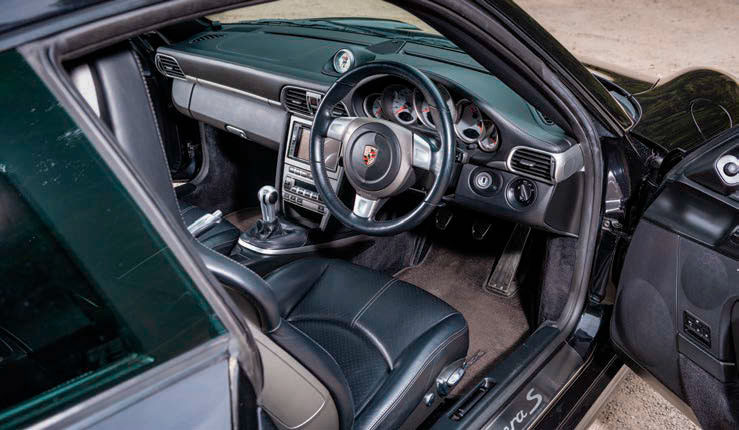
Despite being a rear-engined sports coupé like the 356 before it, the 911 was always going to be a considerably more expensive proposition thanks to the introduction of a six-cylinder powerplant. Concerned the 911’s asking price — some thirty percent higher than the outgoing 356 — would reduce overall sales for the brand, Porsche pulled together a plan of action intended to produce a more affordable, four-cylinder version of its new car, thereby maintaining appeal for Porsche products among less affluent buyers. To keep development costs low, many of the same components, including the body shell, were used across both the 911 and 912.
Initially given the factory designation 902 (to tie in with the 911’s original 901 identifier, which was changed to 911 after a challenge from Peugeot claiming ownership of three-digit model names with a zero in the middle), the car which would go on to become the 912 first appeared in 1965. It fulfilled its maker’s brief to the letter, combining the curvaceous looks of the then new 911 with a simpler, less powerful four-cylinder engine. Options explored, but ultimately discounted, included a new engine based on the flat-six, as well a unit derived from the Type 616/16 powerplant used to propel the 356 SC. In response to concerns about the little amount of cash Porsche had to play with, however, a detuned version of the 356’s regular 1.6- litre engine became the preferred choice. The resulting 616/36 featured cast-iron cylinder liners and a finned alloy jacket in addition to a light alloy crankcase and matching cylinder heads. A pair of twin-choke Solex carburettors and low compression ratio of 9.3:1 meant the new 1,582cc unit developed 90bhp at 5,800rpm. This was down 5bhp when compared to the 356, but the 912’s engine delivered its 90lb-ft torque 700rpm lower than that of its predecessor. A Type 901 four-speed gearbox provided the drive, while 60mph was reached from a standing start in 11.6 seconds. Yes, the 912 was off the pace of the 130bhp 911, but the smaller-engined Porsche still managed to deliver respectable performance, especially at a time when drivers in the USA were experiencing enforced tightening of speed limits — at 115mph, the 912’s top speed was 16mph lower than that of its sixcylinder sibling, yet the smaller-engined Porsche was faster and quicker than the 356 due to a more aerodynamically advanced body and advanced-for-the-time independent suspension.
SAME BUT DIFFERENT
Looking at the 912 and 911 side-by-side, it may have seemed as if buyers were being short-changed, but Porsche was keen to highlight how the four-cylinder car offered considerable benefits over the brawny six-shooter. For a start, superior 44/56 front/rear weight distribution trumped the 911’s 41/59, while the 912’s more neutral handling meant it was less likely to bite at the limit. Helped by its lighter engine and overall weight of just 970kg, the 912 was also more economical, returning close to 35mpg. With a silver rear badge designed to let admirers know they weren’t staring at the model’s more powerful stablemate — 911s wore gold-coloured emblems — the 912 officially entered production on the 5th April 1965. At DM16,250 (£2,466), it cost DM6,000 (£972) less than a 911.
Porsche would soon discover it had a hit on its hands — by the close of 1965, 6,401 912s had shifted out of dealer showrooms. This figure is almost double the 911’s 3,390 sales volume for the same period. Interestingly, until production of the 356 ended in September of the same year, Porsche limited availability of the 912 to continental Europe, but from September onward, the model was available to buy in the USA. With a price tag of $4,700 against the top-line 911’s $6,500, sales success was assured. Though it was built to attract buyers who couldn’t stretch to the pricier 911, the 912 was virtually indistinguishable from the more expensive Porsche. As mentioned earlier, the cars shared the same body, but also the same fifteen-inch wheels and the same 165HR tyres.
Moreover, the 912 used the same size brake discs and the same suspension as the 911. That said, the cars could be told apart if you knew where to look. For example, the 912 made use of plastic interior trim (where wood adorned the 911), and where there was a complement of five dash dials in the faster car, buyers of four-cylinder machine had to settle for three. Also, the 912 lacked the black plastic finish atop the 911’s painted dash, a feature inherited from the 356.
Patience paid off for would-be buyers when the five-dial instrument cluster from the 911 became standard equipment for the 912 in 1967. Fuchs became a cost option, allowing the entry-level speed machine to look even more like a 911 than it already did. Heightened specification, however, attracted heightened cost — in the UK, the cost of acquiring a new 912 rose to £1,974, saving buyers only £462 over shelling out for a 911. At this stage of the story, I must confess to toying with the idea of buying the 912 on these pages back in early 2021. It was in the possession of a friend, Bruce Holder, who some six years earlier had imported the car to the UK from Canada. When Bruce first laid eyes on the Porsche, it was wearing a fibreglass ‘tea tray’, an appendage which makes a 912 or early 911 look hugely ill proportioned. He had the good sense to leave the spoiler in North America when arranging the car’s carriage to Blighty.
The flat-four was long gone and evidence of poorly executed modifications were plain to see, though it would be remiss not to acknowledge this car as a survivor of a time when air-cooled Porsches weren’t worth what they are today, meaning the money spent on them in decades past was commensurate with their value in period. Consequently, the 912 had been the recipient of a frankly terrible paint job (replacing original Light Ivory), unsympathetically installed door speakers, dodgy velour-covered seats and a loosely fitted half roll cage. Much of the brightwork was either missing or poorly painted, though I liked the look of the RS-style bumper, staggered Fuchs alloys and Nardi Torino steering wheel, which Bruce had installed as a replacement for the G-series part “bodged into place”.
I was less enthralled by the floor pans full of water, but a selection of body repair panels (including new floor pans) from Restoration Design were offered as part of the package, which was, in many respects, the perfect blank canvas for an air-cooled Porsche restomod project. After a period of soul searching, however, and with a fleet of fifteen cars (many being in-progress projects) already to my name, I sensibly reasoned I simply wouldn’t have the time required to resurrect this 912. Fortunately, I knew a man who did.
Max Levell is the owner of Revival Cars, a 912 specialist based near Heathrow airport. Able to take advantage of a huge stockpile of parts acquired since the business was established more than twenty years ago, he was more than up to the challenge of turning the fortunes of the car around and did exactly that, replacing both floors, fuel tank supports, brake calipers, master cylinder, clutch, brake lines, dampers, all supporting suspension components and much more besides. As you’d expect, he also installed an engine. The Fuchs, meanwhile, were replaced with the steelies and hub caps seen in our photos. Once up and running, the car was advertised as a rolling project ready for its next owner to personalise as they saw fit.
From Revival Cars, the 912 made its way to Rindt Vehicle Design, where it was swiftly advertised for sale and attracted the attention of Sarah, a Kiwi living near Hitchin. “Back in New Zealand,” she tells me, “my then partner owned a classic 911 Turbo and I drove a 356. I also owned a string of Beetles and old MGs, all of which were all modified in some way. In contrast, the 356, which I adored, was very original and got treated as a garage queen, only coming out to play on sunny days. I moved to the UK in 2002, got married and had kids, which dictated the need for a more practical mode of a transport, but I was able to maintain my interest in German sports cars by way of employment in Hitchin’s Audi dealership. When the kids got older, however, and after my husband and I agreed to separate, I decided to buy another Porsche, a train of thought leading to the purchase of a 2008 997 Carrera 4S.”
DOWN TO WORK
The car was sourced for Sarah by Matt Barnett, owner of Stevenage-based Porsche servicing and maintenance outfit, Renn Works. “In truth, I wanted an air-cooled car, but convinced myself I should buy a more modern, more sensible Porsche,” Sarah continues. “The 997 Matt recommended boasted low mileage, had been in the same ownership since new and was very clean. I bought it and I love it, but to my mind, the 997 doesn’t match the thrill of driving an air-cooled Porsche. You don’t get the sound or smell associated with the older cars, which is why I soon started looking for a classic Porsche to join the 997.”
With the price of acquiring an early 911 now stratospheric, thoughts turned to the 912. “Many enthusiasts vouched for Revival Cars and assured me the work Max carries out is of an excellent standard. Even though the 912 I bought looked a little worse for wear when I first laid eyes on it, I recognised there was a sound 912 beyond the compromised cosmetics.” Proving the point, inspection on a ramp showed the underside of the car to be in fantastic order.
Renn Works was soon welcoming the dinky Porsche to its workshop. “Matt went over the car and took care of any jobs I felt needed attending to in advance of its scheduled appearance at the RSVP Social, an annual gathering of air-cooled Porsches and Volkswagens in Bidfordon- Avon,” Sarah recalls. She hadn’t anticipated the starter motor packing up, though. “I was driving along Marylebone High Street in London when it gave up the ghost. I don’t mind getting my hands dirty, but I was wearing a dress and you need to reach up beneath the engine to tap a temperamental 912 starter motor back to life. Instead, I called the AA for assistance and ordered a replacement starter motor. I’m now much more confident in driving the car big distances. It’s performed pretty much faultlessly and is more than capable of keeping up with modern traffic, even on busy motorways, such is the good health of the engine Max installed.”
The look of the car, she tells us, will be addressed next year. “I want to add plenty of miles to this Porsche and drive it in all conditions while the interior and paintwork is a mess. I like not worrying about the car being dinked in a supermarket car park, unlike my 997, which is perfect by comparison. My enjoyment comes from the sound, smell and feel of driving the 912, not what it looks like, although I don’t mind admitting a dog-leg gearbox in a left-hand drive car on right-hand drive roads took a little getting used to.” Her plan is to have the interior of the car retrimmed in a floral design, reflecting what she now does for a living, but even in its current state, the car is attracting attention wherever it goes, not least Caffeine and Machine, the Ettington-based automotive hangout, where co-founder, Phil McGovern, insisted the 912 took pride of place at a recent air-cooled Porsche meet and has since invited Sarah back for an exclusive photo shoot. Pristine paintwork is, it would seem, entirely supplementary to requirements.
FLICKERING FLAME
The 997 you see on these pages isn’t Sarah’s Carrera 4S — it belongs to Nick Found, a native of Hertford, approximately twenty miles south of Hitchin. Nick too was switched on to Porsches by way of air-cooled classics. “My father was given a 911 SC as a company car in the early 1980s,” he remembers. “Eventually, he took on private ownership of the vehicle and set about a series of major modifications, including a lowered ride height, a four-inch exhaust, staggered Fuchs wheels and Turbo-aping bodywork.”
Progress was stopped in its tracks by a fire in the engine bay. “The original three-litre flat-six was totalled,” Nick reveals, before confirming the car’s character was positively enhanced by its replacement engine. “Dad bought a flat-six which had previously been used to power a professional 911 rally car. I remember the sound and look of the exhaust spitting flames after installation! Dad used that 911 every day. It had covered 250,000 miles by the time he parted with it.” Needless to say, despite a deep love for the output of Lotus, Nick always hankered after a Porsche to call his own.
It’s fair to say the 911 has dodged many bullets throughout its near six-decade existence. After the Stuttgart sports machine was pulled back from the brink of death in the 1980s, the following decade redefined the model, but new beginnings didn’t come without controversy — the arrival of the water-cooled 996 in 1997 was Zuffenhausen’s most pronounced rethinking of the original Neunelfer concept. Despite cries of disdain from purists upset at the new 911’s joint development with the ‘lesser’ 986 Boxster, however, the 996 was a necessary reaction to Porsche having to embrace modern technology and call time on its line of air-cooled cars. Thankfully, the move proved to be a huge commercial success, laying the foundations for Porsche to become the world’s most profitable carmaker (on a per-unit basis).
Fast, hugely capable and refined, the 996 was a pivotal 911, but its production fortunes would be roundly eclipsed by what was to follow. Introduced in 2004, the 997 is sometimes referred to as little more than a revised 996 with reinstated round(ish) headlights. This oversimplification is an error. Development began in late 1998.
Porsche design wizards, Grant Larson and Matthias Kulla, ably guided by then department head, Harm Lagaay, conceived the 997 as a cabriolet first and a coupé second. The rationale for this seemingly unorthodox approach to vehicle design? It was argued the additional chassis stiffness needed for the open-top would also benefit the fixed-roof model. Traditional cues, such as the narrow waist and the aforementioned headlamps, recalled past iterations of the 911, while aerodynamic honing reduced the Cd figure to 0.28. Broad wheel arches covered wider tracks and revised suspension, with eighteen-inch rims offered as standard equipment on entry-level cars.
Additionally, where the 996 banished the 993’s dated cabin furniture and dash layout, the 997 introduced another completely new design, one incorporating hints of what had already been warmly received by reviewers of the Cayenne. Standing the test of time, the 997’s cockpit still feels fresh today.
The £58,380 Carrera and £65,000 Carrera S were first from the blocks. The former produced 321bhp from its 3.6- litre six-pot and sprinted to 62mph in five seconds. With an enlarged 3.8-litre lump and 295lb-ft torque, the 350bhp Carrera S was speedier still. This was the first time in twenty-seven years the 911 was offered with a choice of different engine sizes from the off. Better still, the optional X51 power pack lifted the Carrera S’s output to a lofty 376bhp. A six-speed gearbox was shared between models, while the hugely capable five-speed Tiptronic S transmission was a key feature on the Porsche dealer options list.
The Carrera S rode on nineteen-inch rims with Porsche Active Suspension Management (PASM) as standard. A Porsche debut – and the first time electronically controlled springs and dampers had been offered since the 959 – PASM enables firmer suspension at the touch of a button. The optional Sports Chrono Package Plus – clearly identified thanks to the presence of a dash-top stopwatch – added more dynamic polish, adjusting engine and throttle pedal mapping, as well as intervention of Porsche Stability Management (PSM). Variable ratio rack-and-pinion steering also debuted on the 997, delivering a distinctly direct-yet-progressive feel. The upgrades were transformative, as proven when the Carrera S lapped the Nordschleife a full twenty seconds faster than the 996.
Understandably, Porsche was confident in its new car’s pace and technical supremacy, as highlighted by a relaxing of service intervals to 18,000 miles, thereby easing the ownership experience, though most specialists and owners, including Nick, err on the side of caution by sticking to more frequent fluid changes. The Carrera and Carrera S soft-tops debuted at the Detroit Motor Show in January 2005. Universally praised, the new 911 was a solid foundation on which to build. Uprated rear suspension mounts promised to reduce vibration, while the automatically erecting rear spoiler extended an additional twenty millimetres more than the equivalent coupe component. The larger dimensions aided directional stability, and although the canvas roof added eighty-five kilograms to the 997’s overall weight, the panel could be raised or lowered in just twenty seconds.
The wide-hipped, four-wheel drive Carrera 4 and Carrera 4S rolled in next. Though power was the same as the rear-drive Carrera and Carrera S, the 4 and 4S transmission’s viscous multiple-plate coupling sent a minimum five percent power to the front wheels, increasing to a maximum of forty percent when traction was poor. Further increasing driver control, Porsche Ceramic Composite Brake (PCCB) discs were offered as a desirable cost option, while the new Porsche Communication Management (PCM) entertainment interface was standard equipment across the range.
“It had to be a Carrera S,” Nick replies to our enquiry about the search leading to the 997 seen here. “From the moment I saw photographs of the model in 911 & Porsche World back in 2004, I knew I wanted one. I was fourteen years old and spent my evenings drooling over photographs in the magazine.” Most boys his age were looking at a very different type of magazine back then, but for Nick, there was nothing more exciting than the rear end of a 911.
“I remember being disappointed by the look of the 996,” he muses. “I was dismayed by how much of its componentry was shared with the Boxster, though I appreciate why this was necessary. When the 997 was released, I felt a weight lifted. Porsche had seen the light and had finally got the cash to come out with what felt like a truer successor to the 993. All the best bits of the 996 had been carried over, but the 997’s interior was sharper, its wheel arches were flicked out and inspiration for the headlights came from a compass, rather than the morning’s breakfast!”
Reviews in 911 & Porsche World, as well as from tellybox favourites, Top Gear and Fifth Gear, assured audiences the 997 brought changes which weren’t only skin deep. PASM, for instance, meant the 911 could switch from being a comfortable GT car to a boneshaking asphalt attacker at the touch of a button. “The 997 produced hit after hit, from the GT3 to the GT3 RS 4.0 and, of course, the amazing Sport Classic, the car I never knew I needed, but believe me when I say I do! When I was finally in a position to buy a 911, the choice was simple — armed with modest budget and a fixation on the classic 911 concept, I bought a Carrera S, combining rear-wheel drive with the normally aspirated 3.8-litre M97 engine. To my mind, this is the 911 recipe distilled into a relatively affordable and usable performance package.”
Following four months of searching, Nick found the Basalt Black belter on the Auto Trader website in August 2021. “I refreshed searches every hour,” he smiles. “When I contacted the seller, he told me he’d only posted the details online thirty minutes earlier. At first, he thought I was an Auto Trader representative calling to confirm the listing was live. It was at this point I realised how obsessed I’d become!”
Channelling this energy, he enlisted the help of a good friend and went to view the car that very evening. “It was in London,” he says. “We turned up at the seller’s house just before dusk. People often talk about the affluence of tree-lined streets being a good way to judge whether a car is coming from a good home. Well, this was a Porsche-lined street. The car was gleaming, but had an honesty about it, suggesting it hadn’t spent a week with a detailer being prepped to cover up anything untoward.”
BOX OF DELIGHTS
Expecting he’d have to compromise on specification or colour, Nick was thrilled to be looking at a 911 featuring everything he desired from 997 specification, including manual transmission, Sport Chrono, BOSE audio, a fire extinguisher, electrically operated hard-shell Sport seats, the Porsche crest embossed in the head rests, a short shifter, a switchable exhaust system and a sunroof. The deal was done and the car was making its way in the direction of H-Town a short while later.
A subsequent call to Porsche Cars Great Britain’s Owner Services manager revealed the car was originally used as a client loan vehicle by Porsche Centre Chiswick, where it remained for eight months from first registration in April 2007. This, perhaps, is why the car is so well equipped. “These are the toys I thought I’d need to retrofit to a 997 over time,” Nick gasps. “I’d seen these features spread across many different 997s, but until finding this car, not in the same 911.” Outside of servicing at official Porsche Centres, supporting paperwork highlighted maintenance and repairs by respected specialists, Autofarm, JAZ Porsche and GT One.
Did the car live up to expectation? “Where my Lotus Elise is fragile, the 911 is anything but. I can use this car in all weather year-round, whereas the Lotus leaks and the windscreen steams up in winter. Unless the roads are bone dry and the sun is out, it’s not a particularly enjoyable car to drive. In contrast, my 997 is a joy in all conditions, although unlike when I’m behind the wheel of the Lotus, nobody wants to let me out of junctions!”
He tends to his cars little and often, taking care of regular servicing ahead of the manufacturer’s recommended intervals and making subtle changes to improve the driving experience, whilst promoting mechanical longevity. A low-temperature thermostat has been fitted and a twenty-hour session with a machine polisher has brought the Basalt Black paintwork back to its best. PPF is on the cards, as is a suspension upgrade, with Bilstein and Öhlins products currently fighting it out for Nick’s affections. He’s also keen to book his 911 in for a stay at Renn Works, where Matt will be tasked with replacing the engine’s rear main seal and IMS. Prevention is better than cure, after all.
Echoing sentiment Sarah expressed earlier, Nick tells us he’s loved getting to know his Porsche and has thoroughly enjoyed the process of working out how best to drive it. “It’s been a learning curve, but I’ve enjoyed every minute of determining how to attack corners and power out of them, resulting in the unbeatable feeling of the rear end hunkered down and stuck like glue to the road. The car can be completely docile at low speed, but comes alive with Sport Chrono activated and my foot to the floor. Leaning on the rear end and powering out of bends is nothing short of wonderful. This car has so much character. The drive is never boring.”
What advice would he give 911 & Porsche World readers thinking about buying a 997 after reading this article? “Be aware of the well documented problems with the M97 engine and make sure there’s plenty of documentation backing up claims of careful maintenance.
Understand the car’s history, but most of all, try to determine which 997 is best for you. Will it be your everyday vehicle? Will it only come out in the dry? What is the condition of the roads you’re likely to be using the car on? What is your driving style? Be clear and honest with yourself before jumping to a purchase — there are a wide variety of 997s available in a range of body styles and with various engine options. There really is a 997 for everyone. Answer these questions and you’ll be able to secure an example ideally suited to your preferences, thereby making your ownership experience that much more rewarding.”
The differences between the two Porsches we’ve paired outside Hitchin are obvious, but the 912 and 997 share a willingness to be used as daily drivers. They’re no-nonsense sports cars, as happy in slow moving traffic as they are blasting around backroads. The rearengine layout and revhappy boxer engine in each car provides a thrill conventional configuration can’t muster — spend time exploring the capabilities of either a 912 or 997 and you’ll be rewarded in spades. “This car is everything I want it to be,” Nick beams. Sarah nods in agreement. “Porsche ownership never fails to live up to expectation. It’s totally addictive,” she says. Now, when is the next H-Town meet taking place? I sense a run out to Hitchin on the horizon…
Above
The 997 was offered with a good selection of alloy wheel designs over and above the standard ‘lobster claw’ five spoke Right Racing toward the next H-Town meet, yeah?! Above 3.8-litre M97 flat-six delivers a useful amount of power, which Nick has learned to harness through long periods of seat time getting to know his 911. Above The first-generation 997 is regarded by many Porsche enthusiasts as the last of the ‘analogue’ 911s.
NICK WAS THRILLED TO BE LOOKING AT A 911 FEATURING EVERYTHING HE DESIRED FROM 997 SPECIFICATION
Above Low mileage has resulted in an incredibly tidy car, which carries many desirable cost options Below Nick’s 997 was originally used as a customer loan car by the team at Porsche Centre Chiswick.
VARIABLE RATIO RACK-AND-PINION STEERING DEBUTED ON THE 997, DELIVERING A DISTINCTLY DIRECT-YET-PROGRESSIVE FEEL
Above Following a childhood spent drooling over his father’s modified SC, Nick’s 2007 997 Carrera S is the realisation of his dream to own a 911. Above and below Sarah isn’t fussed about the cosmetic condition of her 912 — it enables her to leave the car in parking lots and to drive in all weather conditions without worrying about scuffs or scrapes.
IN MANY RESPECTS, THE PERFECT BLANK CANVAS FOR AN AIR-COOLED PORSCHE RESTOMOD PROJECT
Above Something of a bitsa, Sarah’s Porsche has been put back on the road following years it spent impotent after import from North America in 2015. Above The 912 was based on the sameage 911 and shares many of the bigger-engined Porsche’s components, including its body.
Above Different eras of Porsche production delivering the same sense of fun to their owners.
Below Max at Revival Cars got the 912 up and running with a high number of replacement parts, including a recommissioned flat-four engine.
WITH A PRICE TAG OF $4,700 AGAINST THE TOP-LINE 911’S $6,500, SALES SUCCESS WAS ASSURED


